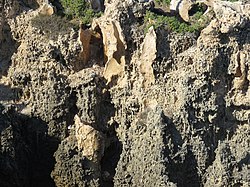
Tamala Limestone is the geological name given to the widely occurring eolianite limestone deposits on the western coastline of Western Australia, between Shark Bay in the north and nearly to Albany in the south. The rock consists of calcarenite wind-blown shell fragments and quartz sand which accumulated as coastal sand dunes during the middle and late Pleistocene and early Holocene eras. As a result of a process of sedimentation and water percolating through the shelly sands, the mixture later lithified when the lime content dissolved to cement the grains together.
Exposed limestone formations at The Pinnacles Desert near Cervantes clearly show the limestone formation through the sedimentary process. At its thickest, the Tamala Limestone comprises the massive Zuytdorp Cliffs, up to 250 m high, extending for 150 km between Kalbarri, Western Australia and south of Steep Point.
Commercial uses
Because of its ready availability, Tamala Limestone is used extensively for landscaping and building in Western Australia and particularly for the main population centre of Perth.
The two main sub-types quarried commercially are Carabooda Limestone and Moore River Limestone. The Carabooda type is from the Wanneroo/Yanchep region close to Perth. It has a creamier colour and is slightly denser than Moore River limestone which comes from the area around Guilderton and which is darker and more textured.
Usage
A very selective list from a 1984 publication from the Geological Survey of Western Australia.
- Perth Mint
- Old Perth Boys School
- Old Perth Fire Station
- Perth Gaol and Courthouse
- Swan Barracks
- St Mary's Cathedral, Perth
- Winthrop Hall
See also
References
- Geological Survey of Western Australia (1984), A Guide to the building and facing stones of Perth and Fremantle, Western Australia Dept. of Mines, Geological Survey, ISBN 978-0-7244-8673-1
Further reading
- Lipar, M., Webb, J.A., 2014. Middle–Late Pleistocene and Holocene chronostratigraphy and depositional history of the Tamala Limestone, Cooloongup and Safety Bay Sands, Nambung National Park, southwestern Western Australia. Australian Journal of Earth Sciences 61 (8), pp. 1023–1039.
- Hearty, P.J., O'Leary, M.J., 2008. Carbonate aeolianites, quartz sands, and Quaternary sealevel cycles, Western Australia: a chronostratigraphic approach. Quaternary Geochronology 3, pp. 26–55.
- Gozzard, J.R., 2007. Geology and Landforms of the Perth Region: Western Australia Geological Survey (126 pp.).